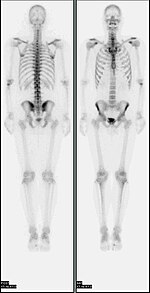Bone scan
| Bone scintigraphy | |
|---|---|
| Medical diagnostics | |

A nuclear medicine whole-body bone scan. The nuclear medicine whole-body bone scan is generally used in evaluations of various bone-related pathology, such as for bone pain, stress fracture, nonmalignant bone lesions, bone infections, or the spread of cancer to the bone.
|
|
| ICD-9-CM | 92.14 |
| OPS-301 code | 3-705 |
| MedlinePlus | 003833 |
A bone scan or bone scintigraphy /sɪnˈtɪɡrəfi/ is a nuclear medicine imaging technique of the bone. It can help diagnose a number of bone conditions, including; cancer of the bone or metastasis, location of bone inflammation and fractures (that may not be visible in traditional X-ray images), and bone infection.
Nuclear medicine provides functional imaging and allows visualisation of bone metabolism or bone remodeling, which most other imaging techniques (such as X-ray computed tomography, CT) cannot. Bone scintigraphy competes with positron emission tomography (PET) for imaging of abnormal metabolism in bones, but is considerably less expensive. Bone scintigraphy has higher sensitivity but lower specificity than CT and MRI for diagnosis of scaphoid fractures following negative plain radiography.
Some of the earliest investigations into skeletal metabolism were carried out by George de Hevesy in the 1930s, using Phosphorus-32. In the 1950s and 1960s Calcium-45 was investigated, but as a beta emitter proved difficult to image. Imaging of positron and gamma emitters such as Fluorine-18 and isotopes of strontium with rectilinear scanners was more useful. Use of Technetium-99m (99mTc) labelled phosphates, diphophonates or similar agents, as in the modern technique, was first proposed in 1971.
...
Wikipedia
